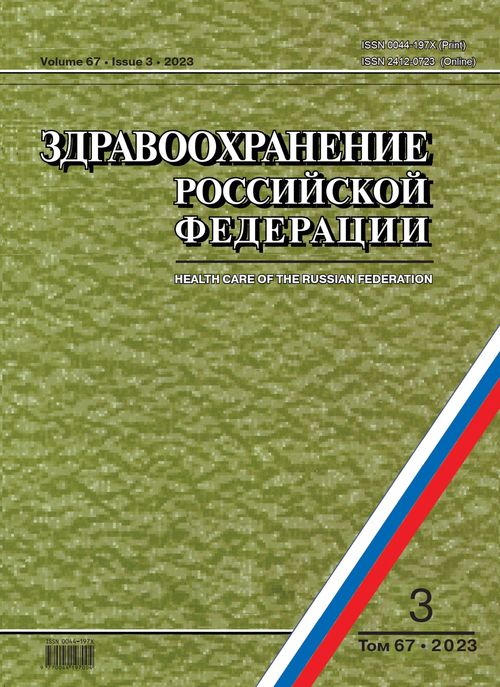Thermal injuries in the Siberian region
- Autores: Shapovalov K.G.1, Emelyanov R.S.1, Mikhailichenko M.I.1
-
Afiliações:
- Chita State Medical Academy
- Edição: Volume 67, Nº 3 (2023)
- Páginas: 211-216
- Seção: HEALTH CARE ORGANIZATION
- ##submission.dateSubmitted##: 25.10.2024
- URL: https://rjonco.com/0044-197X/article/view/638045
- DOI: https://doi.org/10.47470/0044-197X-2023-67-3-211-216
- EDN: https://elibrary.ru/foflto
- ID: 638045
Citar
Texto integral
Resumo
Introduction. Thermal lesions represent a significant medical and social problem, they are characterized by the duration and high cost of treatment, a significant proportion of the limitation or disability. In Siberian region besides burn injuries, cold injury is common.
The purpose of the work was to identify factors influencing the indicators of specialized medical care for patients with thermal injuries in the Siberian region.
Materials and methods. The analysis of the reports of the main specialists of the subjects of the Siberian Federal District on the provision of specialized medical care to victims of thermal injuries in 2017 was carried out. Statistical processing was performed using the Microsoft Excel for Windows 10.0 program.
Results. The average provision for victims of thermal trauma is 2.8 beds per 100,000 of the district’s population, the turnover rate per 100,000 of the population is 134, the mortality rate is 4.6%. The hospitalization rate for patients with burns per 100,000 populations is 39, with cold injury — 6.0. In the structure of adult patients, non-core patients hospitalized for a “burn” bed occupy 12%. The mortality rate in adults is 10 times higher than in children. For each specialized bed for a patient with thermal injuries, 6.4 beds intensive critical care are required. Over 12% of victims in intensive care units require mechanical ventilation. The rate of anesthetic management per patient varies in subjects by 6 times.
Limitations. The study was conducted on the basis of available official statistical data, primary data were not used.
Conclusion. Cold trauma has a significant impact on the performance of the medical care system in the Siberian Federal District for patients with the “combustiology” profile. The variability of a number of key parameters in the provision of specialized care for thermal trauma is due to different numbers and densities of the population, the degree of industrialization and the financial capabilities of the region. A significant proportion of those treated in burn hospitals are patients with another (without thermal injury) pathology.
Compliance with ethical standards. This type of research does not require the submission of the opinion of the biomedical ethics committee or other documents, since the main material is based on statistical reporting.
Contribution of the authors:
Shapovalov K.G. — research concept and design, statistical processing, editing;
Emelyanov R.S. — material collection and processing, statistical processing, writing the text;
Mikhailichenko M.I. — material collection and processing, writing the text.
All authors are responsible for the integrity of all parts of the manuscript and approval of its final version.
Gratitudes. The authors express their gratitude to the main freelance consultants of the ministries of health of the constituent entities of the Siberian Federal District in the field of “combustiology” for the preparation of regional reports: Voloshchenko K.A., Butukhanov S.B., Mikhailichenko A.V., Shchedreev A.G., Brezhnev E.V., Khlebnikov A.B., Dartai-ool A.N., Shmyrin A.A.
Acknowledgments. The study had no sponsorship.
Conflict of interest. The authors declare no conflict of interest.
Received: December 21, 2022
Accepted: December 29, 2022
Published: July 06, 2023
Palavras-chave
Sobre autores
Konstantin Shapovalov
Chita State Medical Academy
Autor responsável pela correspondência
Email: noemail@neicon.ru
ORCID ID: 0000-0002-3485-5176
Rússia
Ruslan Emelyanov
Chita State Medical Academy
Email: ruslan.emelyanov.91@mail.ru
ORCID ID: 0000-0001-7145-1624
Assistant of the Department of Anesthesiology of Resuscitation and Intensive Care, Chita State Medical Academy, Chita, 672090, Russian Federation.
e-mail: ruslan.emelyanov.91@mail.ru
RússiaMaxim Mikhailichenko
Chita State Medical Academy
Email: noemail@neicon.ru
ORCID ID: 0000-0001-8660-2982
Rússia
Bibliografia
- Shapovalov K.G. Frostbites in the practice of an anesthesiologist and emergency physician. Vestnik anesteziologii i reanimatologii. 2019; 16(1): 63–8. https://doi.org/10.21292/2078-5658-2019-16-1-63-68 https://elibrary.ru/yxeutr (in Russian)
- Ivanov V.V., Sakharov S.P., Polyakov A.P. Thermal trauma in children is social and economic problem. Meditsinskaya nauka i obrazovanie Urala. 2010; 11(2-2): 32–3. https://elibrary.ru/tshdtx (in Russian)
- Vikhriev B.S., Kichemasov S.Kh., Skvortsov Yu.R. Local Cold Lesions [Mestnye porazheniya kholodom]. Leningrad: Meditsina; 1991. https://www.elibrary.ru/zdzeod (in Russian)
- Shapovalov K.G., Sizonenko V.A., Kovalev V.V., Gordienko S.P., Mikhaylichenko A.V., Konnov V.A. Intensive therapy of local cold injury in children. Detskaya khirurgiya. 2009; (1): 36–7. https://elibrary.ru/kbaxjb (in Russian)
- Alekseev A.A., Alekseev R.Z., Bregadze A.A., Konnov V.A., Mikhaylichenko A.V., Semenova S.V., et al. Diagnosis and treatment of frostbite (clinical recommendations). Available at: http://combustiolog.ru/wp-content/uploads/2013/07/Diagnostika-i-lechenie-otmorozhenij-2017.pdf (in Russian)
- Sizonenko V.A. Cold Injury [Kholodovaya travma]. Chita: Ekspress-izdatel’stvo; 2010. https://elibrary.ru/pftdeg (in Russian)
- Vinnik Yu.S., Salmina A.B., Yur’eva M.Yu., Teplyakova O.V. The local cold-trauma: the problems of pathogenesis, estimation of heaviness and treatment. Moskovskiy khirurgicheskiy zhurnal. 2011; (1): 42–8. https://elibrary.ru/rurldv (in Russian)
- Hutchison R.L. Frostbite of the hand. J. Hand Surg. Am. 2014; 39(9): 1863–8. https://doi.org/10.1016/j.jhsa.2014.01.035
- Yanagisawa H. Hypothermia, chilblain and frostbite. Nihon Rinsho. 2013; 71(6): 1074–8. (in Japanese)
- Murphy J.V., Banwell P.E., Roberts A.H., McGrouther D.A. Frostbite: pathogenesis and treatment. J. Trauma. 2000; 48(1): 171–8. https://doi.org/10.1097/00005373-200001000-00036
- McIntosh S.E., Opacic M., Freer L., Grissom C.K., Auerbach P.S., Rodway G.W., et al. Wilderness medical society practice guidelines for the prevention and treatment of frostbite: 2014 update. Wilderness Environ. Med. 2014; 25(4 Suppl.): S43–54. https://doi.org/10.1016/j.wem.2014.09.001
- Kotel’nikov V.P. Frostbite [Otmorozheniya]. Moscow: Meditsina; 1988. (in Russian)
Arquivos suplementares









